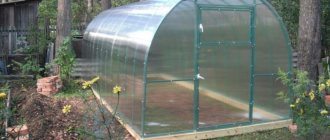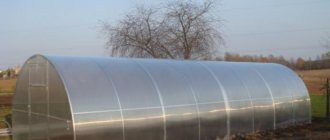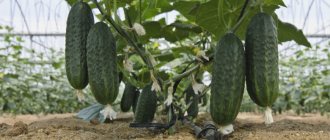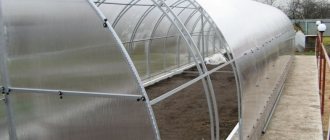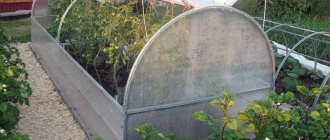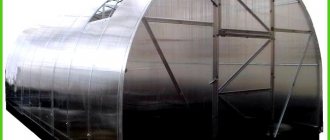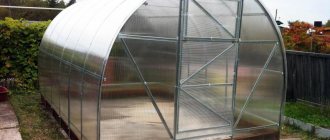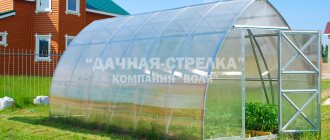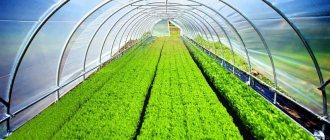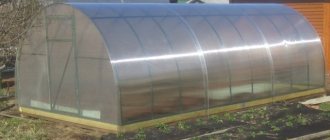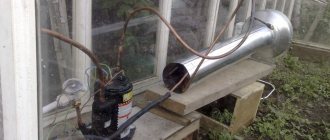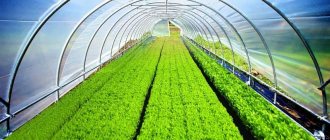Types of greenhouse structures
Farm greenhouses generally differ in type of construction.
Among them are usually distinguished:
- lean-to frames with earthen filling: such greenhouses are the simplest options with the most affordable cost for the farmer, but they are characterized by minimal conditions for growing crops;
- a gable structure with a full roof, which is formed by greenhouse frames - is a traditional option; Also, in large-scale farms, gable greenhouses are used, characterized by the presence of main walls.
Greenhouse structures are also divided according to the type of space organized inside:
- Shelving. Such designs allow you to grow plants on shelves that are equipped with comfortable sides.
- Rackless. These greenhouses are characterized by greater cheapness, since crops grow on the ground.
Farm greenhouses
Farm greenhouses are designed for growing plants based on commercial feasibility. If a summer resident builds a greenhouse to satisfy internal needs, for example, growing vegetables for his table, then the products of farm greenhouses are, as a rule, intended for subsequent sale. In order for the greenhouse to be profitable, it is made in large sizes and is intended mainly for growing plants of the same type. In addition, farm greenhouses create conditions for year-round cultivation of plants.
However, the construction of large greenhouses also entails high costs. This is especially true for coverage costs. For example, one of the best in terms of its physical characteristics is glass. But the price, complexity of installation and dismantling negate its advantages, mainly where a quick return on investment is required. This primarily concerns small and medium-sized farmers, who are the absolute majority. In this situation, a good solution is to cover it with film, which has its own advantages and disadvantages.
Features of materials
Most farm greenhouse structures are intended for year-round use, so their construction requires the use of modern building materials. The revolution in greenhouse construction was the use of polycarbonate as the main material for frame coverings.
Polycarbonate is a relatively new building material that is increasingly being used for efficient agriculture. This is due to the unique combination of technical and operational properties in this plastic.
Polycarbonate has the following characteristics:
- its main difference is its high strength;
- it has a warming function;
- it does not interfere with the penetration of light rays, blocking harmful radiation;
- easy technology for disassembling the structure makes transportation of the greenhouse convenient;
- the material is very durable and reliable, its characteristics are not inferior to light metals, but is lighter in weight;
- When assembled with your own hands, such greenhouses allow cutting without the use of special equipment.
When using this material for greenhouse structures, it is worth knowing about its disadvantage: polycarbonate is a synthetic material, so it does not ensure environmental safety, but companies producing this plastic strive to eliminate as much as possible the harmful effects on plant crops.
Practical farm greenhouses made of polycarbonate
A farm greenhouse occupies a significant area and has a strong base and foundation. Due to the fact that the structures are quite tall, wide and have an entrance gate, this allows you to place various agricultural supplies and equipment inside. They can also be used as temporary storage. A farm greenhouse made of polycarbonate is a protective structure for large-scale farming.
Polycarbonate greenhouses have a number of advantages:
- Simplicity of design. Quickly disassembled and assembled, easily transported to any other place.
- The strength of the frame material, which can withstand large changes in temperature and humidity.
- Possibility of equipping a heating system that allows plantings to ripen during the coldest period. Multi-level laying of heating system pipes.
- The heifers are equipped with manual and automatic watering systems.
- Availability of artificial lighting.
- Low thermal conductivity due to the finishing material, which allows you to maintain constant humidity and temperature that plants need.
- Lightweight polycarbonate plates.
- High resistance and strength to aggressive internal and external conditions.
- Eco-friendly - the material will not disintegrate due to moisture or time.
- Thermoplastic - the polymer slowly melts at high temperatures, and when cooled, it hardens and restores its properties.
- It is highly impact resistant and can withstand greater weight loads than glass.
- Has a high degree of light transmission.
A new spunbond nonwoven material that appeared on the market several years ago is used in medicine, furniture production, construction and other fields. In agriculture, this material is used as a covering sheet or as a material for greenhouses.
Shelters on personal plots and cottages differ from industrial and farm greenhouses mainly in size. The use of greenhouses allows you to create and maintain the required temperature and humidity and install irrigation, lighting and heating systems.
Features of film greenhouse structures
Film greenhouse structures are a lightweight version of glass and polycarbonate greenhouses. A metal frame is selected as the basis for such greenhouses, which is then covered with film.
The main advantages of such greenhouses are:
- resistance of the material to biological negative influences;
- waterproof;
- low price category.
Film greenhouse structures on a metal frame are popular precisely because of their affordable price. However, it is worth considering that the reduced cost of the material is very rarely combined with its high quality. The film is significantly inferior in strength to polycarbonate. Also, over time, during operation, its ability to transmit light decreases. Experienced farmers say that the film coating must be changed after 2-3 years.
Types of year-round farm greenhouses
There are 2 types of greenhouses - seasonal and year-round. Farm greenhouses are divided depending on the facing material (film, polycarbonate and glass). Each material has positive and negative qualities.
The most budget-friendly, easily accessible and easy-to-install option is a farm greenhouse made of film (not winter options). But the film greenhouse is short-lived, rarely survives the winter, you have to cover it with new film every season, and quickly breaks in bad weather. A more expensive material is glass. Glass greenhouses are installed on a more durable frame. In such structures, the air inside heats up much faster, so it is necessary to think about ventilation so that this does not affect the health of plants and vegetables. The downside is that if the glass breaks, it is quite problematic to remove the fragments and replace the coating.
They have increased thermal insulation and low thermal conductivity, the lightest weight, high transparency, due to the porosity of the material, light is scattered. They are protected from chemicals when cultivating land. They are durable - service life reaches 10 years. Due to the flexibility of the sheets, the greenhouse can be given any appearance. The disadvantages of the greenhouse may appear if the sheets were installed incorrectly during installation, then ultraviolet rays will penetrate inside, which will shorten the service life. Also, due to the porosity of the sheets, if dirt or water gets in, the light transmittance will be lost.
Greenhouse frames are:
- Wooden;
- Metal;
- PVC.
Wooden frames are used less frequently, due to the need to constantly treat them with a chemical composition against pests and corrosion, so they are not buried in the ground without special insulation. Metal frames do not rust and are durable when processed once, but this support is the most expensive. Frames made of polyvinyl chloride (or PVC) consist of plastic that does not rot, does not require additional maintenance, is durable and lightweight.
Using additional equipment
To ensure efficient growth of agricultural crops, in addition to greenhouses, additional equipment is needed to create microclimatic conditions:
- Ventilation systems allow you to clean the air environment inside the greenhouse complex.
- Shading technology will minimize exposure to dangerous sun rays.
- Year-round farm greenhouse complexes are often equipped with multi-circuit heating systems. Advanced greenhouse configurations allow the farmer to independently adjust the distribution of coolant units based on the requirements of a specific greenhouse complex.
- No less important are irrigation systems, the pumping equipment of which is configured using programs that allow, if necessary, to reproduce sprinkling and drip irrigation.
Wear-resistant greenhouses Farmer: areas of use
The purchase of any item must be of practical importance, otherwise there is a high risk of wasting money. If we talk about greenhouses, then, as mentioned earlier, its installation is justified if there is a need for year-round cultivation of various crops. Besides this, there is another important caveat. We are talking about growing agricultural crops on an industrial scale. If the summer resident does not have any, then it is better to give preference to another model.
In addition, the greenhouse is used in a number of other cases:
- Covering device for outdoor swimming pool;
- Storage place for things and garden tools;
- Garage;
- Production room.
The design of the greenhouse is designed taking into account the need for industrial cultivation of crops. In addition, the structure can be used as a warehouse, a garage, and even a shelter for an outdoor pool.
DIY greenhouse assembly
Basically, the frame is produced in the form of a ready-to-assemble kit consisting of frame elements made of metal. The frame should only be mounted using the fasteners that are included in the basic package.
The most important stage in creating a greenhouse complex is laying the foundation. Typically, a concrete base is used for the foundation, divided into columnar and strip types. Massive greenhouses require the creation of trenches, concrete is poured into it, and then power rods are immersed into it, on which the structure is installed.
Polycarbonate, glass or film can be used as a coating. The simplest frame covering is considered to be a film system, which is fixed using fasteners to the frame connection elements.
Farm greenhouse frame options
A farm greenhouse can have different types of frames. The most common and traditional design has a gable roof. Industrial greenhouses use 2-3 roof ridges. Hangar-type or arch-type greenhouses and their modifications with a pointed arch are also quite popular.
It is much easier to provide ventilation with a single-pitch or gable structure, in contrast to a similar arched greenhouse. It is quite difficult to equip an additional window on the side surface, so many manufacturers are content with windows located above the doors on both sides of the greenhouse. If fresh air is necessary, then it is worth choosing other types of greenhouses.
approximate cost
The high cost of farm greenhouses is determined by their size compared to country houses. Thus, a 5-meter frame base with a 2-meter thickness and the same height costs about 60 thousand rubles. These dimensions represent the initial dimensions for creating a greenhouse, and the most optimal can be considered 10x5x3 meters, which costs an average of 125 thousand.
A more specific cost is calculated taking into account the use of additional equipment. For example, a greenhouse with automatic lighting, heating and ventilation costs about 200 thousand.
The structure in detail: greenhouse “Farmer” 7x5
How to protect plants from the cold: heating a greenhouse with your own hands
The effectiveness of a greenhouse depends on how correctly it was assembled. As already mentioned, a foundation is not required for it, but this does not mean that it is possible to lower the degree of vigilance. It all starts with the formation of a wooden base.
Due to the fact that we are talking about a 7-meter greenhouse, a drip irrigation system is required.
It would be a good idea to pay attention to the recommendations listed below:
- Installation of an automatic control system for humidity and temperature levels;
- The presence of evenly distributed sensors that monitor vital parameters in real time;
- Availability of a ventilation system;
- Installation of an artificial lighting system for seedlings;
- Installation of a sprinkler irrigation system;
- Installation of horizontal and vertical shading systems.
The choice in favor of a 7-meter greenhouse is justified when planning to develop high-altitude crops on an industrial scale. In order to avoid problems at the stage of practical operation, at the design stage it is necessary to determine the width, height and a number of other parameters. Irrigation, shading and ventilation systems are selected depending on the demands of the crops.
Advantages of the structure
If you make a “Farmer” greenhouse with your own hands, you can get a harvest all year round. And since the agricultural structure includes special engineering systems, the size of the harvest increases significantly.
Do-it-yourself installation of a building can be done on the foundation or directly into the ground. Farmer greenhouses may differ from each other in the layout of the internal space, dimensions and design.
The buildings are suitable for both private use and industrial use. Since “Farmer” greenhouses are expensive, it makes no sense to purchase them for yourself; it is better to build them yourself.
Consumer Reviews
Reviews about the presented type of greenhouses are mostly positive. First of all, gardeners like the structure because it can be assembled with their own hands. There is only one drawback - high cost.
Assembly of the structure is easy, but it is better if 3 people are involved - it’s more convenient. It is recommended to place the greenhouse on a foundation, but you should not use red brick for this purpose. There is enough light in the greenhouse, as well as ventilation. In winter, snow does not accumulate on the roof. The metal profile does not rust.
Specifications
The presented greenhouses can have a width from 6.0 to 12.5 meters. The buildings have side openings with a manual folding system. There is also a sliding door with double doors. The gables are made of polycarbonate.
Greenhouses "Farmer" are expensive, it makes no sense to purchase them for yourself; it is better to build them yourself
The roof is made of blown double film, which has a long service life. The material is anti-condensation, fixed to the frame using aluminum elements. The store-bought version assumes that the kit includes a corresponding motor for inflating the film.
The frame of the building is erected using semi-arches. They are made from galvanized pipe whose diameter is 32/28 millimeters. Thickness – one and a half millimeters.
The length of the greenhouse can be any. The distance between the arches reaches two meters. The height of the ridge is 4.5 meters. The straight stand has a height of 2.5 meters.
You may also be interested in the article in which we talk about the choice and rules for installing heated floors in a greenhouse.
The frame of the building is erected using semi-arches. They are made from galvanized pipe
Installation Rules
To grow plants in a greenhouse with your own hands all year round, you should provide a heating system in advance. You can also install thermal insulation materials, which will reduce heating costs. A vestibule can act as an additional element for heat conservation.
Assembly of the frame is very simple. Arc-shaped elements made of galvanized profiles are taken and connected using purlins to each other and to the end elements. The width of the building can be anything from 4.2 to 7.5 meters. The height can reach 4 meters. The length of the greenhouse must be a multiple of 2.1 meters. The minimum length is about 4.2 meters.
The frame is assembled using nuts and bolts. The ends are secured using brackets. The top is installed using polyclips. The thickness of the polycarbonate should be from 6 to 10 millimeters.
The building can be placed directly on the ground or on the foundation. An automated drive can be installed to the side vents. Electric ventilation can be installed indoors.
To grow plants in a farm greenhouse with your own hands all year round, you should provide a heating system in advance
We invite you to learn about the AquaDusya drip irrigation system.
Infrared heating of a greenhouse
The idea of infrared heating for my greenhouse did not come immediately.
My first greenhouse was heated with water heating from a stove in which water was heated and circulated through pipes.
It seemed to me that this heating was ineffective for several reasons:
- I constantly had to be on duty and add firewood every 40 minutes:
- It was difficult to control the temperature in the desired range. The temperature constantly fluctuated between hot and cold
- the heat from the radiators rose upward, and the earth did not warm up well, and as a result the plants grew poorly.
I read about infrared heaters, which heat objects inside the greenhouse, and from them the air is heated, and I decided to make infrared heating in my greenhouse. I immediately ordered four 1.5 kilowatt infrared heaters and two thermostats.
But then, when I received them, at first I was disappointed, having calculated the required power for my greenhouse, it turned out to be very little (I need about 25 kW in the winter), since the thermal insulation in the greenhouse, whatever one may say, is still weak, and in winter it happens at minus 30C, I won’t see such power in the village.
Well, as they say, every cloud has a silver lining, I brought these IR heaters home, looked at how they work, out of my curiosity and decided that there would also be a place for them in my greenhouse.
I came up with an idea on how to use simple gas IR heaters for targeted heating of the earth.
My whole idea is to use reflectors from gas IRs and redirect the heat beam downwards, dispersing it over a large area, since gas heaters cannot be directed with the radiating surface downwards.
I made the reflectors from ordinary galvanized steel, and took the burners with a power of 3.6 kW of the GIIV-3.65 brand.
I connected them to a gas cylinder, I had to install 4 of these burners and 4 electric infrared to maintain the set temperature.
Thus, I got combined infrared heating.
I want to warn you that if you connect more than one burner to one cylinder during prolonged operation, the cylinder may freeze, especially when there is little gas left, and the burners may go out, and after some time the gas will flow again, so you need to monitor this.
Gas doesn't like jokes. I won’t tell you how I solved this problem, because I’m afraid that someone will try to install the same sensors as I did but will not adjust them correctly and an explosion may occur, use the services of specialists.
And so there were frosts -32C degrees, my greenhouse withstood them, the temperature in it remained strictly +21C degrees, although in the morning I barely opened the door, it froze from the street to the box.
To automatically control the temperature in the greenhouse, a thermostat is used.
Using a thermostat, the electric IR turns off when the air in the greenhouse reaches a certain temperature.
Thus, a constant temperature is maintained. In addition, additional energy savings occur.
Thanks to the thermostat, the greenhouse can be left unattended without fear of a fire hazard.
Film professional greenhouse for the farmer
At the base of the structure is an arch curved outward. From a practical point of view, this eliminates the need to remove snow and other types of sediment. In addition, the curved shape improves light penetration, which in turn speeds up the growth process.
In this regard, it was necessary to think about options that were more durable in all respects. This was the Farmer greenhouse, equipped with a metal frame.
It gives the structure the following characteristics:
- The frame is made by cold galvanizing, which eliminates corrosion;
- It is possible to place additional ventilation ducts on the side surfaces;
- The assembly process does not involve the use of welding;
- The presence of end vents ensures the flow of fresh air;
- It becomes possible to install additional equipment and a lighting system.
A wear-resistant, impact-resistant greenhouse is installed when the gardener plans to grow flowers, berries or vegetables all year round. Thanks to the curved roof, water and snow do not linger on the surface. The presence of a metal frame provides additional strength and makes it possible to install a lighting or ventilation system.
